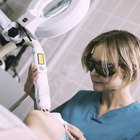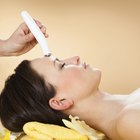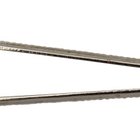
One of the first places wrinkles begin to crop up is on the forehead. Botox and dermal fillers have made eliminating these wrinkles without surgery a possibility. With the intense popularity of both types of products, identifying which method will work best for you can prove difficult. Choosing the best route depends in large part on the types of wrinkles you have.
Types of Wrinkles
As an important component of facial expression and a victim of constant sun exposure, it's no wonder the forehead is prone to wrinkles. Over time, vertical “11” lines crease their way between the brows. Expressive horizontal lines begin to etch across the forehead. Sometimes, especially in individuals with a heavy brow and lids, the constant need for the forehead muscles to pull up the sagging brow can also result in a forehead striped in deep creases. Throw in the aging process, when skin begins to lose its elasticity, and resting wrinkles crop up as well.
Botox
Dynamic wrinkles, those caused by muscle movement, tend to respond best to Botox. The bototulinum toxin in Botox temporarily impairs the nerve functioning of the muscle it's injected into. The relaxed muscle is then unable to produce the movement that results in wrinkling of the skin. Examples of dynamic wrinkles in the forehead are the "11" lines and the horizontal lines that are prominent with frowning and other facial expressions. Botox is effective for about 3 to 4 months.
Dermal Fillers
Static wrinkles are those that are visible when the face is relaxed and at rest. As people age, the dermal layer of the skin becomes thinner. The loss of elasticity and fullness is manifested in static wrinkles. Dynamic wrinkles can also eventually become permanent and no longer disappear when the face is relaxed. Dermal fillers can help eliminate these types of wrinkles by adding volume to the dermal layer. This plumps up the tissue, returns it to a state similar to that of youth and pushes out the creases. Types of fillers range from hyaluronic acid fillers like Restylane to collagen fillers like Cosmoplast. Injections of fat are also used as fillers. The duration of results and possible side effects vary with the type of filler used.
Considerations
Whether Botox or dermal fillers is the right choice for you will depend upon the positioning of your facial muscles and the type of wrinkles you have. In some cases a combination of the two is needed to smooth away both static and dynamic wrinkles. Also, the muscular structure of the forehead in some people may predispose them to unwanted side effects, such as eyelid drooping. With so many different factors to consider, it’s important to discuss your treatment options in a consultation with the health care provider who will be treating you.
Warning
While Botox and dermal fillers are cosmetic procedures, they are also drugs with the potential for serious complications. Numerous scams have been identified for both Botox and dermal fillers. The Centers for Disease Control warns there are substantial risks associated with cosmetic procedures performed by unlicensed practitioners. Look for a board-certified dermatologist, plastic surgeon or cosmetic surgeon when you are searching for someone to perform cosmetic procedures. Even then, check the providers' credentials, education and the amount of experience they have with these products.
Related Articles

Anti-Aging Face Exercises

Do Facial Exercisers Improve the ...

The Wrinkle Rub Out Technique for the ...

Laser Treatment for Face Wrinkles

What Do the Horizontal Lines on the ...

Negative Effects of Endermologie

Is It Possible to Get Rid of Knuckle ...

Collagen & Rosacea

Estrace Cream for Wrinkles

Photofacial Vs. Microdermabrasion

Side Effects of Syn-Ake

The Differences Between Men's & Women's ...

How to Determine the Width of Faces

Thinning Skin on the Neck

How to Remove Hair Follicles to Prevent ...

Exercises for Bags Under the Eyes & ...

The Average Prices for Laser Skin ...

Risks of Facial Fillers

How do I Speed Up the Reversal of Face ...

Can Age Spots Be Reversed?
References
Writer Bio
Journalist and medical writer Patti Kelly has been writing health and parenting articles within the health care industry since 2004. A registered nurse, she has experience as a direct care provider, medical writer and translator. Kelly holds a Bachelor of Arts in English, Spanish and French from Simpson College and is also fluent in American Sign Language.
Photo Credits
the girl with green eyes image by Yuriy Poznukhov from Fotolia.com